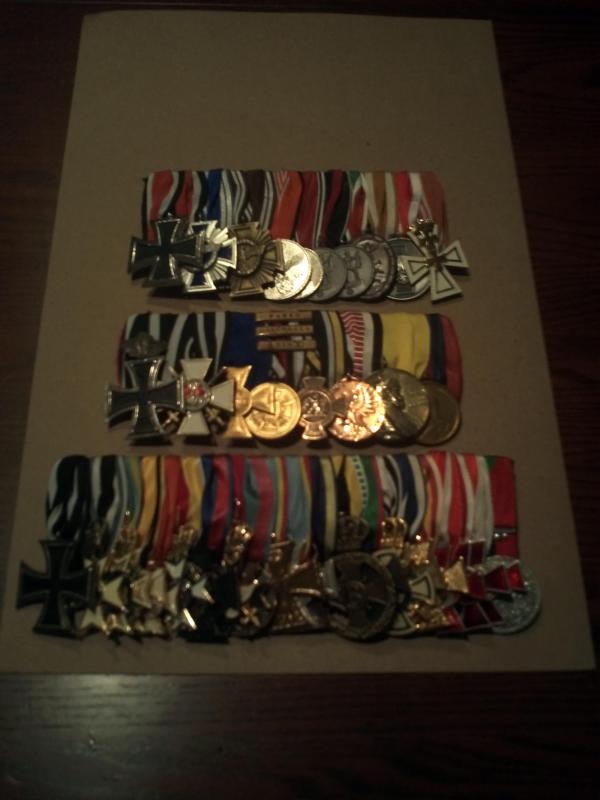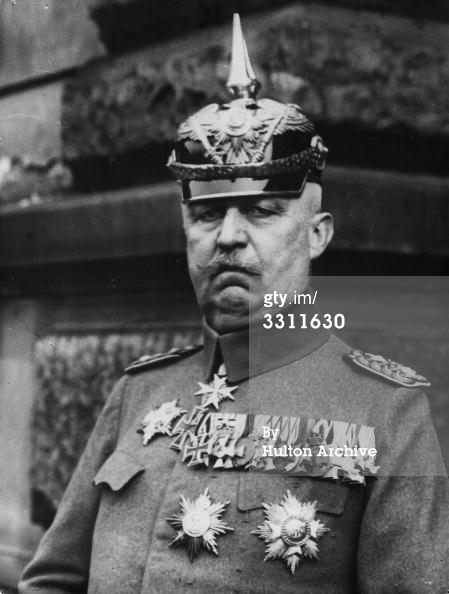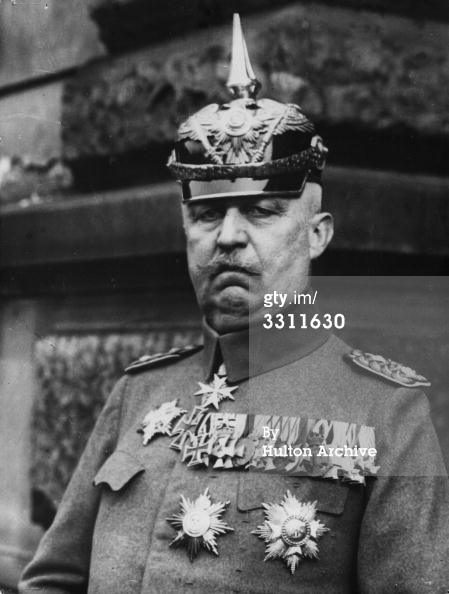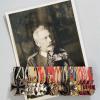-
Posts
591 -
Joined
-
Last visited
-
Days Won
2
Content Type
Profiles
Forums
Blogs
Gallery
Events
Store
Posts posted by filfoster
-
-
Re Rank List Speak, Ludendorff is credited with a "BMJ1", which is some level of the Bavarian Military Max Joseph Order
See this thread:
. http://gmic.co.uk/index.php/topic/56836-hanseatic-bars-show-yours/page-3?hl=ludendorff#entry532672
What is this? It does not correspond to the published 'glossary' of these in the pinned topics. Is it a Commander's Cross? The pinned menu says the regular knight award is BMMJO.
The above thread also does not seem to include a Grand Cross award for the Max Joseph, which some posters have credited him with.
Thoughts?
0 -
Is anyone else concerned that this does not follow the pre-war or wartime Prussian (he was Prussian) order of precedence, although, if #2 is the Max Joseph, it approximates the Kaiser's 21-place medal bar in precedence?
The Max Joseph at #2 would not be according to the published orders of precedence but only the Royal Hohenzollern Household Order 3rd with swords would come before the Red Eagle 3rd, but the medal in the photo does not have the HOH shaped cross arms.
The #4. medal could also be a Crown Order and appears to have 'swords'
So, now we have:
1. Ek2
2. Saxon St. Henry (could have been BMMJO but he was gazetted the BMJ1) Better: Max Joseph?
3. Red Eagle 3rd with crown
4. 25 year long service cross Better: Crown Order with swords?
5. Centenary Medal
6. Mecklenburg Schwerin Military Merit Cross
7. Mecklenburg Strelitz Cross for Distinction in War
8. Hesse General Honor Decoration for Bravery
9 Oldenburg Friederich August Cross
10. ?
11. Brunswick War Merit Cross
12.Saxe-Meiningen Cross for Merit in War
13. Lippe-Schaumburg War Merit Cross
14. Lippe-Detmold War Honor Cross
15.Hanseatic Cross Hamburg
16.Hanseatic Cross Bremen
17. Hanseatic Cross Lubeck
0 -
4.) Prussian 25 Year Officer Long Service Cross
5.) Centenary Medal
8.) Hesse General Honour Decoration for Bravery
Thanks; But then what is #10?
0 -
Surely someone knowledgable must know what these are. OK, I will guess
1. EK 2
2. Saxon St. Henry
3. Red Eagle 3rd with crown
4 ?
5.Hessian General Honor Decoration For Bravery (medal and ribbon also look like Centenary Medal)
6. Mecklenburg Schwerin Military Merit Cross
7. Mecklenburg Strelitz Cross for Distinction in War
8. ?
9. Oldenburg Freidrich August Cross
10. Long Service Cross ?
11. Bruswick War Merit Cross
12. Saxe Meiningen Cross for War Merit
13. ?
14. ?
15-17 Hanseatic Crosses
0 -
Andy and Glenn, thank you for helping to clear this up for me. It appears the post war photos show him with the white underlay on his shoulder boards commemorating his appointment as 'chef' of the 39th Fusilier regiment.
Now, if only someone could identify all the medals he's wearing in that photo, I could reproduce a great display.
0 -
Andy, thanks for your suggestion but the article claims that he both commanded the 39th Fusiliers and was later made 'chef'.
This article http://www.theodora.com/encyclopedia/l2/erich_ludendorff.html claims that Ludendorff was the commander of the 39th Fusilier Regiment before WW I, perhaps 1913, and later, on the date of his resignation, 26 October, 1918, he was made the 'chef' of the regiment. The post-war picture seems to show white underlay to the shoulder boards.
It seems to clear this up we need answers to two questions:
1. Does anyone have better documentation of his being named the 'chef' of the regiment on 16 October 1918?
says he was appointed 'chef' of the 39th on 1 November 1917.
This article also says Ludendorff was assigned command of the 39th 27 January 1913. (scroll up one page)
2. Was white the correct shoulder board underlay color for this regiment at that time?
0 -
This source http://www.theodora.com/encyclopedia/l2/erich_ludendorff.html
confirms Ludendorff as 'chef' of the 39th Fusiliers as of 26/10/1918. That would most easily explain the very white appearance of the shoulder board underlay on the post war photographs of him, as in the thumbnail attached to my original post.
0 -
Perhaps the white of Füsilier-Regiment Nr. 39 of which he was "Chef".
Regards
Glenn
Glenn: Thanks for this. That would be my guess, given the very light color of the photographs. I had searched to see if he was an honorary 'chef' or 'ala suite' to any regiments and had not found this. Great info and until someone has more conclusive documentation or persuasive arguement, that is what I will go on. P
0 -
Anyone know if this bar still exists or has anyone tried to copy it?
As an example of copy medal bars, I am attaching a thumbnail of some that I have made:
The bottom one is the Kaiser's as in my avatar.
 0
0 -
Andy: Thanks for your reply. I had thought of that but would need another precedent. For example, Alfred von Schlieffen wore Great General Staff uniform (See thumbnail) when he was the Chief of the Great General Staff.
Does anyone have a verification that Schlieffen's facing colors worn on that uniform were crimson/carmine red, rather than general's poinceau or 'poppy' red?
 0
0 -
In the medals and decorations forum, I have asked what medals Ludendorff wore in many photos (see the thumbnail attached).
As First Quartermaster General, with the substantive rank of General of Infantry, what color underlay is he wearing to his shoulder boards in thie thumbnail? The most logical color would be red, for a general, but even accounting for the perversity of the photo process at that time, (Hindenburg's bright yellow underlay for collar tabs and shoulder boards always looks dark), the color looks too light to be red. Can any one solve this mystery? Virtually no online reference or image I have found shows the color clearly.
This is frustrating since he was among the best known figures of the Great War.
 0
0 -
I searched this and am surprised it was not done to death before. If I missed it, please direct me to the thread.
Has anyone identified all the medals on Ludendorff's well-photographed medal bar?
http://commons.wikimedia.org/wiki/File:Erich_Ludendorff_1918.jpg
Other than Danile Krause's post last year identifying all his awards in the shorthand notation that I can just barely get through, no one seems to have done this.
Here is Mr. Krause's submission
Ludendorff, Erich GdI 1.OQM Ch GS plmE, RAOGKEX, RAO1EX, RAO3SKr, KO2, HOH2aX, EKGK, VK, DA, HEK1X, AK, BZ1X, BrK2, BMJ1, BMVO, BH, HH, LüH, HT, LKEK, MG2b, MMV1, MStMV1, MStMV2T, OV1XmL, OK1, RK, SH1, SH2a, SA1gStX, GSF2aX, EH1X, CK, SMK, WVK1X, WM1, WM2, WK1X, WK2c, ÖL1K, ÖL2aK, ÖEK1K, ÖFJ2a, ÖM1K, ÖM2K, ÖGrSL, JM3, SS1, TH
His bar looks to be about 17 medals, just 4 behind the Kaiser's famous one. Any takers here?
 0
0 -
-
no one has photos for this?
0 -
When were enameled officer Guard stars introduced for wear on Foot Guard officer and General officer pickelhauben? Were earlier versions without enameling?
I am particularly interested in the version of this worn during the 1870-71 war.
0 -
I have posted this on the uniforms forum but wanted to cover all the bases. Does anyone have a photo of any Party or Eastern Territories or General Government officials wearing the double breasted undress tunic with a medal bar? I seem to recall having seen this before but it was evidently not 'regulation' and I cannot find any photos that show this.
0 -
This may belong in the medals and decorations forum but we'll start here. Were medal bars worn with any of the double breasted tunics, usually worn as undress? I have scoured my limited resources for any pictures of Diplomatic Corps or NSDAP or Eastern Territories higher ups wearing medals with their DB jackets and have come up short. I seem to recall a photo of either Franz Xavier Schwartz or one of the Gauleiters wearing this combination but cannot find it now. It must have been uncommon but was it ever done, e.g. receptions, etc.?
0 -
"Maybe on this big photo you can see if he is wearing the First Class of Grand Cross breast star.
In any case, it seems that if an award of first class consisted of two parts (decoration on neck and chest), it used to take only one of the two parts. For example, Ludendorff usually wears the Star of Commander of the Order of Hohenzollern House in the chest, but I've never seen him with the Commander Cross around his neck. Surely he chose to wear the Star of the Grand Cross of the Red Eagle Order, but not the Grand Cross around his neck."
____________________________________________________________________________________
My response:
Someone with better references will have to clarify that there is a First Class of the Grand Cross. I thought most Prussian orders, the Grand Cross was a superior grade to a First Class and not itself divided into classes. In ohter words, there may be variations such as with swords or oakleaves but a Grand Cross is sui generis and not divided into further classes. Anyone have the statues on this?
In any event, the photo seems to show Ludendorff wearing the first class star with swords, not the higher grade that he was gazetted. This is not a common practice, is it?
0 -
This photo is dated on 1923, during the Beer Hall Putsch trial. It's not a pre-date of the Grand Cross award.
I thought so but it's odd that he denies himself wearing the higher grade of the Red Eagle and the neck badge which was very striking and a popular medal to wear, although perhaps not with the other 'heavy' (superior) neck orders he is wearing in the photo.
0 -
Grand Cross with Oakleaves and Swords gazetted 25.09.17 replacing the 1st Class with Swords gazetted 31.03.17
Grand Cross with Oakleaves and Swords gazetted 25.09.17 replacing the 1st Class with Swords gazetted 31.03.17
It is interesting that there are few if any photos of him wearing the corresponding neck decoration for this award. The 'motto' ring around the center medallion also does not look like the dark blue enamel of the Grand Cross, so this photo seems to pre-date the later award. Does anyone have a photo of him wearing either the breast star or neck decoration for the Grand Cross award?
0 -
The new Verlag publication "Der Deutschen Generale" (English version available) answers this: Parades, specific ceremonial occasions. This book has fantastic color photos of surviving examples of virtually every aspect of the uniforms of generals of the German states, for the period 1888-1910 or so, before the introduction of the field gray service uniform.
0 -
Hoyden R wrote:
"In 1812, the French issued the "Bardin Regulation" which describes the undress jacket as a single breasted undressed coat with one row of buttons, upright collar and turned back cuffs. This is what the Undress Coat that you have above is based on . The Prussians introduced in 1814.
You may also want to locate a copy of David Nash's The Prussian Army 1808-1815."Thank you! This is what I wanted. Your post demonstrates a deep knowledge of this subject. It is unfortunate that the readily available sources (well, the Osprey books are certainly readily available but I did not think to look into this volume. Perhaps the 'staff' would have been a good clue to do so), do not have a simple explanation for a uniform that by its use in the period portraiture, was popularly worn by high ranking Prussian officers.
I will try to scare up a copy of Mr. Nash's book.
0 -
Hoyden R, these are good references but for the RUSSIAN army of that time. Blucher was a cavalry general of the PRUSSIAN army and the uniform guides/references that I have found all describe double breasted kollets. Yet, as shown above, the senior generals and the king himself, were painted wearing the single breasted dark blue tailcoat with red collar and Swedish cuffs.
Can anyone please direct me to a reference for Prussian uniforms of this time that describes a single breasted coat with plain collar and cuffs for generals?
0 -
No one interested in Napoleonic Prussian generals? Figure painters? Uniform collectors?
0




Saxon Military Order of St. Henry, Grand Cross to Ludendorff?
in Germany: Imperial: The Orders, Decorations and Medals of The Imperial German States
Posted · Edited by filfoster
Posting now three threads on this Ludendorff character, can anyone confirm that he received the Grand Cross of the Saxon Military Order of St. Henry? The online sources maddeningly disclose 12 recipients in WWI and then only name five, not including Ludendorff. I would suppose that he did get it but cannot find a definitive confirmation.
It is interesting to note that the man who was, perhaps the most powerful man in Germany in 1917 and 1918, is poorly served by written accounts of his uniform details or his military awards and decorations. I have found nothing that is comprehensive. Apparently the Kaiser's personal disdain for him is shared by historians and collectors.